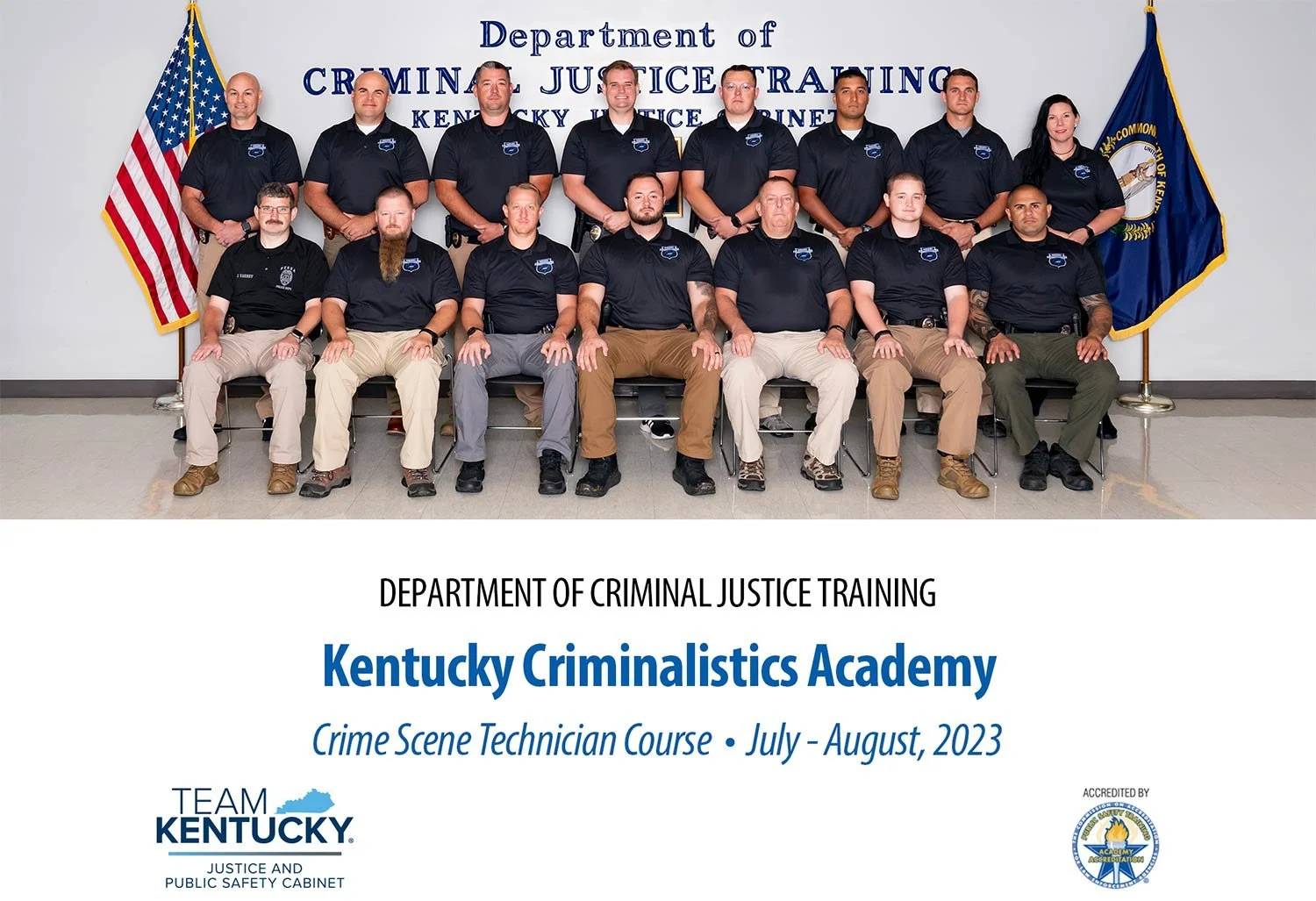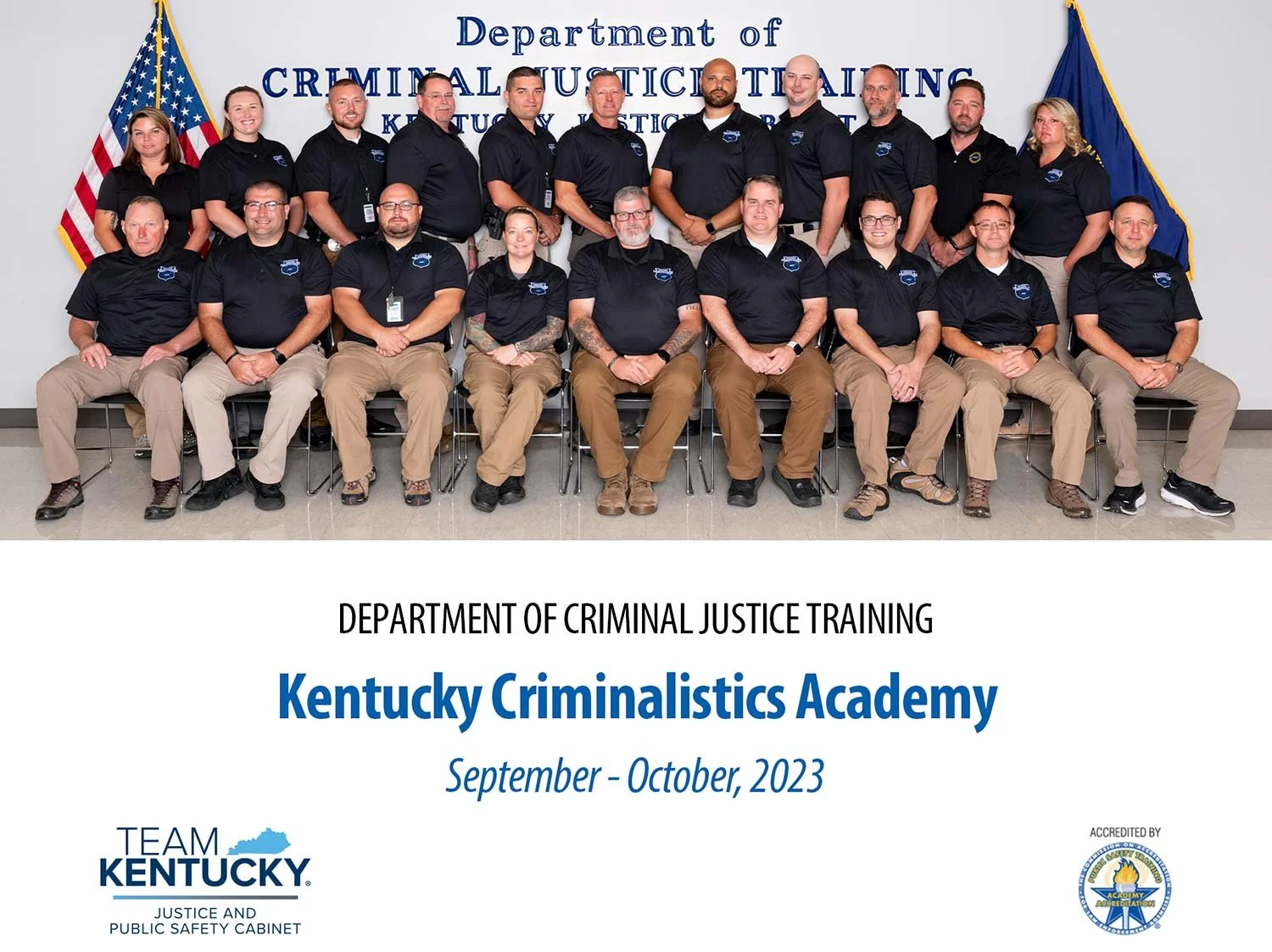It’s in the Details
In early March 2020, when construction crews were finishing improvements to the Kentucky Criminalistics Academy (KCA) training space at the Department of Criminal Justice Training, instructors and staff couldn’t wait for students to thrive and learn within the upgraded environment. However, the COVID-19 pandemic ensured they did just that—wait—as necessary safety precautions were enacted.
But, fast-forward to August 2021, and the excitement to showcase the updates to this facility has not waned. The upgrade is currently being utilized to train its inaugural classes of Kentucky’s law enforcement on crime scene investigation and documentation skills, starting with a Bloodstain Pattern Identification and Documentation in-service class held Aug. 30 –Sept. 3.
Officer Gene Jones with the Elsmere Police Department and Davies County Deputy Chris Hayes conduct a blood-spatter experiment in the recently updated lab located at the Department of Criminal Justice Training during a Bloodstain Pattern Identification and Documentation class. (Photo by Critley King-Smith)
“We are excited,” said Patrol Techniques Section Supervisor Larry Sennett, who worked with architects on the design. “We have all been champing at the bit to get people in here to use the space … It’s the first time we get to get in here and get our hands dirty.”
The improvements include:
a large, 36-student classroom
a blood-spatter room
a state-of-the-art forensic lab
a low-light photography room
According to Sennett, in addition to the entire space being larger, the lab is safer for students and staff with an eye-wash station, chemical storage cabinets that allow liquids and powders to be separated, and a proper ventilation system with exhaust hoods at every work table to eliminate chemical fumes and particles from irritating participants’ lungs. The laboratory has an independent air-handing system from the rest of the academy, which operates continuously for additional safety. Both the lab and the blood-spatter room feature specialized epoxy floors to allow for proper disinfection where needed.
The blood-spatter room has six dedicated cameras that allow instructors to film and slow down the video to show students how impact causes spatter to hit a wall, create a pattern or a stain. Instructors can also use the room to teach how to use Luminol and BlueStar, chemicals that cause certain elements within the blood to fluoresce, even after those elements are no longer visible to human eyes.
Additionally, the low-light photography room allows students to document fingerprints developed with florescent fingerprinting powders and/or chemicals. Photographic painting with light and time-exposure photography, two processes that allow for clearer night images. These techniques are a must since most crime scenes and roadway fatalities occur at night. Crisp, low-light photography skills, such as light painting, are essential to capture images in the dark when standard flash photography can fail.
Another benefit to the photography room is the ability for students to practice techniques during the day and during class hours. Before, they had been forced to do projects and classwork after hours or by finding an empty classroom they could darken, said Sennett, noting that theme carries across the update. Instead of rooms and equipment having to be retrofit by instructors for students to meet their training goals, the updated space has been created to specifically meet the needs of DOCJT clients during both KCA and in-service courses.
Bloodstain-course participant Detective John Dunn from Highland Heights Police Department, who is also the Campbell County Crime Scene Team commander, praised the space’s improvements, specifically regarding its use of smart screens as opposed to old-style, on-wall projection in the classroom, which features additional cameras that have already been utilized for online instruction.
The detective also noted the benefits of specialty courses, such as the one he attended.
“Young officers should get into these trainings earlier in their career, rather than later. If you are interested in crime scene or detective work, these classes are fundamental,” he said, adding that such courses are also aids to investigation, analysis and courtroom testimony.
Kentucky Criminalistics Academy
Developed by DOCJT instructors in 2007, KCA is a 400-hour forensics program divided between two five-week blocks taught in consecutive years. The first phase, the Crime Scene Technician Course, includes basic crime scene processing, digital photography, advanced latent fingerprint development, forensic mapping, digital evidence collection, case preparation and court testimony.
During the second phase, students delve into intense, specialized training in fingerprint identification and comparison techniques, shooting reconstruction, bloodstain pattern identification and documentation, and how to properly document and process a bomb/improvised explosive device scene instructed by agents from the Alcohol, Tobacco, Firearms and Explosives(ATF) agency. Typically, students also visit the Forensic Anthropology Center in Knoxville, Tenn., to learn about human bones and how to locate, map and excavate clandestine graves.
“The Kentucky Criminalistics Academy has served the commonwealth for more than a decade as an exceptional opportunity to earn knowledge that is highly specialized and in-depth,” said DOCJT Commissioner Nicolai Jilek. “As a graduate of the National Forensic Academy, this field of training is near and dear to my heart. I’m excited about the additional capabilities we can offer our clients in their pursuit of justice.”
KCA is available to officers within Kentucky whose main job is to process and investigate crime scenes. The academy aims to train each officer who comes through the course with consistent techniques that encourage efficient collaboration between agencies.
The next KCA’s date is currently pending, but those interested should keep an eye on the academy page https://www.docjt.ky.gov/criminalistics, and their agency head’s email.
For information about DOCJT’s available in-service and view a current coursebook, visit https://www.docjt.ky.gov/inservice.












